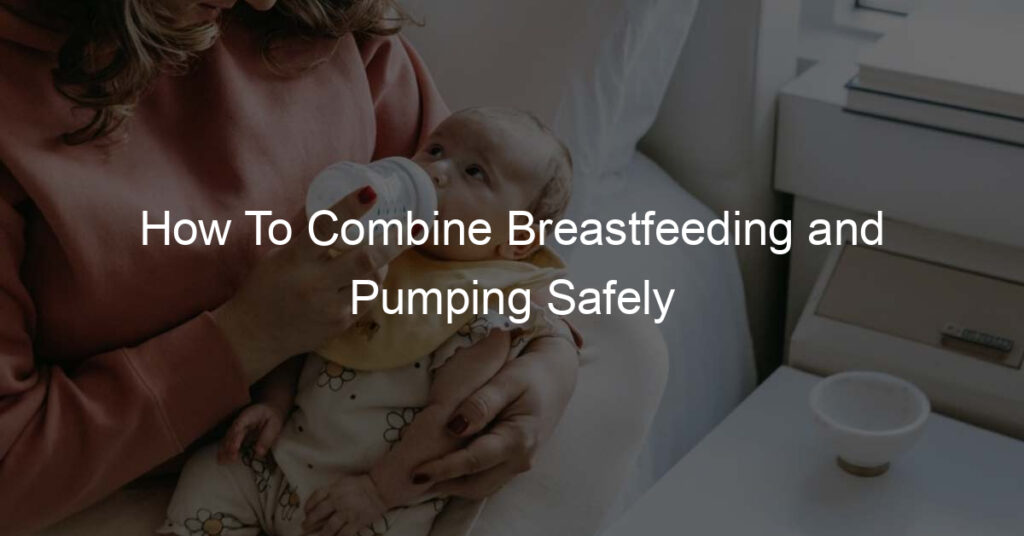As a breastfeeding mom, you may find yourself in a situation where you need to breastfeed and pump at the same time. Perhaps you’re returning to work and need to continue pumping while away from the baby. Or maybe you have an upcoming event where you’ll be away from your baby for a prolonged period.
Whatever the reason, it’s important to know how to safely combine breastfeeding and pumping so that you can maintain your milk supply and provide nourishment for your little one. Here are some tips on how to do just that!
Is it OK to pump and breastfeed at the same time?
Pumping and breastfeeding at the same time is a decision that should be discussed between the parents and their pediatrician. The advantages of pumping and breastfeeding simultaneously can include larger breast milk production due to the development of an additional pumping routine. In addition, two separate routines for multiple children can help promote more consistency with parental care.
However, there are cautions as well; for mothers who may experience discomfort when nursing, simultaneous breastfeeding, and pumping could further exacerbate any associated issues. Furthermore, promoting bonding between mother and child can sometimes be difficult when also using a pump to maintain supply.
Ultimately, finding the right balance between pumping and nursing will depend on individual circumstances.
How do a combo of breastfeeding and pumping?
Combining breastfeeding and pumping can be a great way for new mothers to provide nourishment for their babies while also allowing greater flexibility in terms of nutrition-related planning and maternal bonding. Pumping allows mothers to take time away from their children without sacrificing the nutritional benefits inflicted by breastfeeding as pumped milk can later be provided through bottles when necessary.
However, pumping should never be done instead of getting together with your child and providing them with direct contact; they need your undivided attention during those precious moments. To make the process of combining breastfeeding with pumping easier, it is important to maintain impeccable hygiene, especially when switching between device types like hand pumps or electric ones.
In addition, you should try to store different amounts of milk at specific temperatures depending on how quickly you think your baby might need the meal. With these tips in mind, combining breastmilk and pumping should be much more manageable!
How many times a day should I pump while breastfeeding?
Establishing a good breastfeeding routine is essential in ensuring your baby gets the nutrition and comfort they need. Whether you’re a new mother or an experienced one, it’s important to know how often you should pump throughout the day.
While numerous factors can influence the number of times one pumps each day, such as the baby’s age and any medical conditions, a general rule is pumping every two to three hours when the baby is a newborn up until four months old. After this period, many moms have no problem breastfeeding without needing to pump and can reduce their pumping routine to once every four hours during the day and once before bedtime.
To make sure mom is producing enough milk while maintaining a good milk supply, she should consider having at least one uninterrupted 8-10 hour stretch overnight without having to pump.
How can I keep my milk supply while pumping and breastfeeding?
To ensure your milk supply while pumping and breastfeeding, it is important to establish a regular and consistent feeding schedule. Your baby should have access to your breast as often as possible during the day and at night if that’s what works for you both.
Regardless of whether you’re pumping or nursing, it is vital to provide enough stimulation to the breasts for them to get the message that more milk needs to be produced. Eating healthy balanced meals with plenty of calories, drinking lots of water, avoiding any type of smoking or alcohol ingestion, and getting adequate amounts of sleep will help keep up your supply.
An extra few minutes of skin-to-skin contact after each feeding session can also work wonders in keeping up your milk production levels.
Should I pump after nursing to empty the breast?
Deciding whether pumping after nursing is right for you can be a difficult decision to make. On the one hand, it can give you more milk over an extended period, especially if your baby isn’t taking in all the milk being produced. On the other hand, it can exhaust the breast and cause some stress for mothers with low milk production.
Ultimately, what is best for you will depend on your situation and preferences. If you are worried about getting enough milk or have had problems with supply issues, consider talking to a lactation consultant who can help guide you through this decision-making process.
Concluding Thoughts: How To Combine Breastfeeding and Pumping Safely
In conclusion, combining breastfeeding and pumping is a great way to keep your baby nourished and build up a milk stash for when you’re away from them. It’s important to remember, however, that the success of doing so depends on how well you prepare for each session and monitor your supply.
Some of the key components of combining both approaches include timing pumps between feedings so that you don’t buy overactive letdown, keeping careful track of how often your baby has eaten, ensuring you’re pumping for an adequate amount of time and not allowing too much time between breastfeeds and regular expressions.
Taking the steps outlined here can greatly help in guaranteeing successful breastfeeding combined with pumping efforts so that your baby will get all the nutrition they need while allowing you to space out feedings if needed. Don’t be afraid to reach out to a health professional if have any additional questions or concerns about committing to combining these two methods.














